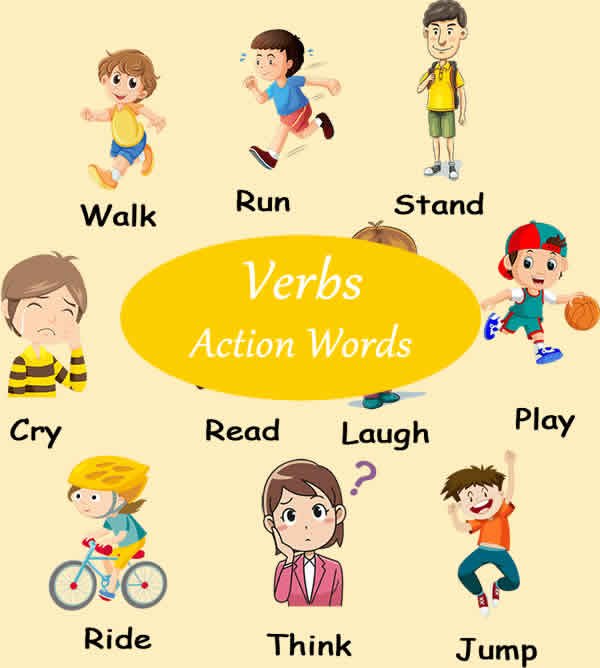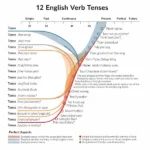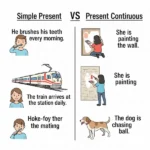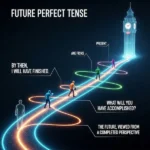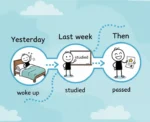What are Verbs? Your Action Heroes in English!
Hello, future English speaker! Have you ever wondered how we describe actions, states, or feelings in English? That’s where verbs come in! Think of verbs as the action heroes of every sentence. Without them, our sentences would be pretty boring and wouldn’t make much sense. Learn more about what are verbs and how to use verbs in English.
In this article, we’ll explore what verbs are, how they work, and most importantly, how to use them when you’re speaking English. Get ready to make your English sentences lively and clear!
What Exactly is a Verb?
At its simplest, a verb is a word that describes an action, an occurrence, or a state of being.
Let’s break that down – what are verbs:
- Action: What someone or something does.
- Occurrence: Something that happens.
- State of Being: How someone or something is.
Examples to Get You Started to Use Verbs:
| Type of Verb | Example Verb | Example Sentence | What it Shows |
| Action | run | I run every morning. | An activity |
| Action | eat | She eats an apple. | An activity |
| Occurrence | become | He became a doctor. | Something that happened |
| State of Being | is | The sky is blue. | How something is |
| State of Being | feel | I feel happy. | How someone is |
Why Are Verbs So Important in English?
You might be thinking, “Why do I need to know this?” Well, verbs are crucial for a few big reasons:
- They complete the meaning of a sentence: Without a verb, a sentence is just a collection of words that don’t tell you much.
- Not a sentence: “My friend a book.” (What about the book? What did your friend do?)
- Sentence with a verb: “My friend reads a book.” (Ah, now we know!)
- They tell you when something happened: Verbs change their form to show if something happened in the past, is happening now, or will happen in the future. This is called verb tense, and we’ll talk more about it later!
- They help you ask questions and give commands: Verbs are key for making your English communication effective.
How to Use Verbs When Speaking English: The Basics
Now that you know what verbs are, let’s look at how to use verbs when you’re speaking.
1. Subject-Verb Agreement: Who Does What?
This is super important! The verb in your sentence must agree with the subject of the sentence. The subject is the person or thing doing the action.
Think of it like this:
- One subject (singular) usually takes a verb ending in -s (in the present tense).
- More than one subject (plural) usually takes a verb without -s (in the present tense).
- “I” and “You” are special – they don’t take the -s even if they are singular.
Let’s look at some examples in the present simple tense:
| Subject | Verb (Present Simple) | Example Sentence | Explanation |
| I | walk | I walk to school. | “I” doesn’t take -s |
| You | walk | You walk fast. | “You” doesn’t take -s |
| He/She/It | walks | She walks her dog. | Singular subject takes -s |
| We | walk | We walk together. | Plural subject doesn’t take -s |
| They | walk | They walk home. | Plural subject doesn’t take -s |
Practice Tip: When you’re speaking, always think: “Who is doing the action? Is it one person/thing or many? Is it ‘I’ or ‘you’?”
2. Verb Tenses: When Did It Happen?
This is where verbs really show their power! Verb tenses tell us when an action happened. (12 English Verb Tenses: The Ultimate Guide with Examples) For beginners, let’s focus on the three most common tenses:
a. Present Simple: For Habits and Facts
Use the present simple for things that happen regularly, or for general truths.
- Structure: Subject + base form of the verb (add -s for he/she/it)
- Examples:
- I drink coffee every morning. (Habit)
- The sun rises in the east. (Fact)
- She studies English. (Regular action)
b. Past Simple: For Finished Actions
Use the past simple for actions that happened and finished in the past.
- Structure: Subject + past form of the verb
- Examples:
- Yesterday, I walked to the park. (Finished action)
- She ate pizza last night. (Finished action)
- They visited their grandparents. (Finished action)
Important Note: Many past simple verbs end in -ed (called regular verbs), but many others are irregular and have different forms (like “eat” becoming “ate”). You’ll learn these as you practice more!
c. Future Simple: For Future Plans and Predictions
Use the future simple for actions that will happen in the future.
- Structure: Subject + will + base form of the verb
- Examples:
- I will go to the market tomorrow. (Future plan)
- It will rain later. (Prediction)
- They will start a new project next week. (Future action)
Chart of Common Verbs in Different Tenses (Regular Verb: “Play”)
| Pronoun | Present Simple | Past Simple | Future Simple |
| I | play | played | will play |
| You | play | played | will play |
| He/She/It | plays | played | will play |
| We | play | played | will play |
| They | play | played | will play |
Chart of Common Verbs in Different Tenses (Irregular Verb: “Go”)
| Pronoun | Present Simple | Past Simple | Future Simple |
| I | go | went | will go |
| You | go | went | will go |
| He/She/It | goes | went | will go |
| We | go | went | will go |
| They | go | went | will go |
3. Using Helper Verbs (Auxiliary Verbs)
Sometimes, verbs need a little help! Auxiliary verbs (or “helper verbs”) work with main verbs to form different tenses, questions, or negative sentences. The most common helper verbs are:
- be (am, is, are, was, were)
- do (do, does, did)
- have (have, has, had)
Examples:
- “be” as a helper:
- “I am studying English now.” (Present Continuous – action happening now)
- “They were playing football.” (Past Continuous)
- “do” as a helper:
- “Do you like pizza?” (For questions in Present Simple)
- “I do not understand.” (For negative sentences in Present Simple)
- “have” as a helper:
- “She has finished her homework.” (Present Perfect – action started in past, relevant now)
| Common Simple Verbs | |||
| run | walk | sit | stand |
| kiss | hug | love | hate |
| cry | laugh | dance | drive |
| eat | drop | kick | jump |
| get | give | keep | learn |
This is just a very small sample of verbs we will use for teaching in this lesson. There are several hundred verbs that can be used in the English language.
How to use Verbs?
Simple examples of using verbs:
Verbs always have a noun either before or after the verb, verbs are not used alone.
- I run
- I walk
- I sit
- I kiss
- Kiss you
- You love her
- You cry
- You eat
- You learn English
More complex examples of using verbs:
- I run to school
- I walk home
- I sit on the chair
- I kiss my mother
- Kiss you tomorrow
- You love her today
- You cry because you are sad
- You eat ice cream
- You learn English for school
Verbs are also used to show present or past tense.
To show something you did in the past (yesterday, last week, etc.), for most verbs, you add “ed” to the end of the verb. For example:
| Present | Past |
| walk | walked |
| kiss | kissed |
| love | loved |
| dance | danced |
| kick | kicked |
| jump | jumped |
| learn | learned |
| I walk to school today | I walked to school yesterday |
| I learn English today | I learned English yesterday |
| I love you | I loved you before |
| I dance all night | I danced with you last night |
| I jump over the water | I jumped into the water yesterday |
Many verbs you don’t add “ed” to the end of the verb. These are called irregular verbs. We will discuss irregular verbs in a different lesson.
50 Most Common Verbs – Present and Past Tense
|
Present |
Past |
|
Accept |
Accepted |
|
Act |
Acted |
|
Bake |
Baked |
|
Behave |
Behaved |
|
Close |
Closed |
|
Compare |
Compared |
|
Compete |
Competed |
|
Die |
Died |
|
Disagree |
Disagreed |
|
Disturb |
Disturbed |
|
Dress |
Dressed |
|
Dry |
Dried |
|
Eliminate |
Eliminated |
|
End |
Ended |
|
Enjoy |
Enjoyed |
|
Fix |
Fixed |
|
Follow |
Followed |
|
Freeze |
Freezed |
|
Fry |
Fried |
|
Greet |
Greeted |
|
Guess |
Guessed |
|
Hunt |
Hunted |
|
Identify |
Identified |
|
Imagine |
Imagined |
|
Invite |
Invited |
|
Join |
Joined |
|
Jump |
Jumped |
|
Knock |
Knocked |
|
Love |
Loved |
|
Manage |
Managed |
|
Mark |
Marked |
|
Match |
Matched |
|
Name |
Named |
|
Need |
Needed |
|
Open |
Opened |
|
Order |
Ordered |
|
Organize |
Organized |
|
Pack |
Packed |
|
Paint |
Painted |
|
Pass |
Passed |
|
Perform |
Performed |
|
Persuade |
Persuaded |
|
Program |
Programmed |
|
Protect |
Protected |
|
Review |
Reviewed |
|
Shop |
Shopped |
|
Slow |
Slowed |
|
Turn |
Turned |
|
Underline |
Underlined |
|
Want |
Wanted |
Additional Helpful Content for Beginners
- Start with High-Frequency Verbs: Focus on learning the most common verbs first (e.g., be, have, do, go, say, make, take, see, come, know). These will allow you to form many basic sentences quickly.
- Listen and Repeat: Pay attention to how native English speakers use verbs in conversations, movies, and songs. Try to imitate them.
- Read Simple Texts: When you read beginner-level stories or articles, try to identify the verbs in each sentence. What tense are they in?
- Practice Speaking Daily: The best way to get comfortable with verbs is to use them! Try to describe your day, what you did yesterday, or what you will do tomorrow.
- Keep a Verb Notebook: Write down new verbs you learn, their past tense forms, and example sentences.
Keep Practicing!
Learning verbs is a cornerstone of mastering English. It might seem like a lot at first, but with consistent practice and by paying attention to how verbs are used, you’ll soon be speaking English with confidence and clarity. Keep practicing, and you’ll become a verb expert in no time! Good luck on your English journey!
Here is a PDF document with 25 practice sentences for using verbs, present tense and past tense. The answers are on a separate sheet.
Additional Helpful Information
- The English verb ‘to be’ – The Verb ‘To Be’: Essential English for Beginners
- Study the 12 tenses of verbs – 12 English Verb Tenses: The Ultimate Guide with Examples
External Links for Authoritative Sources:
- British Council LearnEnglish: A fantastic resource with explanations, exercises, and games for all levels.
- Cambridge Dictionary: Excellent for looking up definitions, pronunciations, and different forms of verbs.
- Cambridge Dictionary (Just type in a verb and explore!)
- Purdue OWL (Online Writing Lab): While geared towards writing, their grammar explanations are clear and reliable for all aspects of English.
